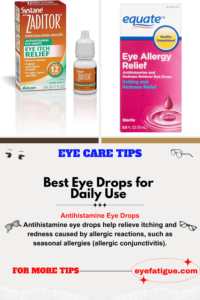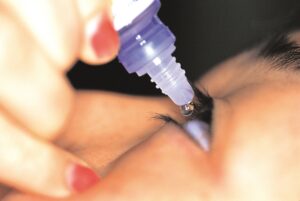Are Your Eyes Thirsty for the Perfect Drops?
Do your eyes often feel fatigued after a long day of screen time? Or you struggle with dryness and irritation due to environmental factors like dust and pollution. Whether you’re facing digital eye strain or simply seeking relief from everyday discomfort, finding the right eye drops for daily use can make a difference.
In today’s fast-paced world, our eyes bear the brunt of constant exposure to screens, air conditioning, and other elements that can leave them feeling dry and tired. Thankfully, the market offers many options for eye drops, each promising to rejuvenate and refresh your vision. But with so many choices available, how do you determine which ones are best for your needs?
Overview: Navigating the Eye Drop Landscape
Finding the perfect eye drops in the vast sea of eye care products can feel like searching for a needle in a haystack. Fear not, weary-eyed wanderers, for we’re here to guide you through the maze of options and illuminate the path to ocular nirvana.

- Lubricating Marvels: Let’s begin our exploration with lubricating eye drops, the unsung heroes of ocular hydration. These moisture-rich elixirs are specially formulated to combat dryness and provide instant relief from discomfort. Brands like Systane and Refresh lead the pack in this category, offering a range of formulations to suit every need. For those seeking relief from dryness, check out our guide on dry eye drops.
- Allergy Alleviators: Ah, the bane of every allergy sufferer’s existence – itchy, watery eyes that just won’t quit. Enter allergy relief eye drops armed with antihistamines and mast cell stabilizers to quell the storm of histamines wreaking havoc on your peepers. From stalwarts like Zaditor and Alaway to prescription-strength options like Pataday, these drops provide a much-needed reprieve from the seasonal assault on your ocular defenses. If you’re dealing with a stye or other irritation, you might also find relief with eye drops for stye relief.
- Redness Reduction Specialists: We’ve all been there – a late night out or an intense gaming session leaves our eyes looking more bloodshot than the surface of Mars. Fear not; for redness relief, eye drops are here to save the day. By constricting blood vessels and reducing inflammation, these magic potions restore your eyes to their sparkling best in no time. Look no further than Visine and Clear Eyes for a quick fix that’ll have you looking bright-eyed and bushy-tailed in seconds. If redness is accompanied by signs of conjunctivitis, learn more about its contagious nature in our article on how long conjunctivitis is contagious for.
- Multi-Purpose Mavericks: For those who demand versatility in their eye care regimen, multi-purpose eye drops are the Swiss Army knives of ocular health. Whether you’re battling dryness, redness, or irritation, these do-it-all solutions have covered you. Brands like Bausch + Lomb and Opti-Free offer comprehensive formulas that address a myriad of eye woes, making them a must-have in any discerning individual’s medicine cabinet.
The Battle of the Drops: A Comparative Analysis
In this section, we’ll compare the leading contenders, evaluating their key features, benefits, and potential drawbacks to help you make an informed choice.
Comparison Table:
| Brand | Type | Active Ingredients | Targeted Concerns | Pros | Cons |
| Systane Ultra | Lubricating Drops | Polyethylene Glycol | Dryness, Discomfort | Provides long-lasting relief, Preservative-free | It may cause temporary blurriness |
| Zaditor | Allergy Relief Drops | Ketotifen Fumarate | Itching, Redness | Fast-acting, Suitable for daily use | It may cause mild stinging upon application |
| Visine | Redness Relief Drops | Tetrahydrozoline HCl | Redness, Irritation | Rapid redness reduction, Instant relief | Prolonged use may lead to rebound redness |
| Bausch + Lomb | Multi-Purpose Drops | Propylene Glycol, Glycerin | Dryness, Redness, Irritation | Versatile, Suitable for contact lens wearers | It may require frequent reapplication |
Systane Ultra: As a lubricating drop powerhouse, Systane Ultra boasts polyethylene glycol as its active ingredient, ensuring prolonged relief from dryness and discomfort. Its preservative-free formula makes it a top choice for those with sensitive eyes, although some users may experience temporary blurriness post-application.
Zaditor: Zaditor emerges as a frontrunner, with ketotifen fumarate as its star ingredient for allergy sufferers seeking rapid relief. Its fast-acting formulation targets itching and redness with precision, though a mild stinging sensation upon application may deter some users.
Visine: When combatting redness and irritation, Visine reigns supreme, with tetrahydrozoline HCl as its secret weapon.
Bausch + Lomb: Rounding out our lineup, Bausch + Lomb’s multi-purpose drops are a jack-of-all-trades solution for dryness, redness, and irritation. However, frequent reapplication may be necessary for optimal results.
Tips for Optimal Eye Drop Usage
Congratulations! You’ve chosen the perfect eye drops to soothe your weary eyes. But before you embark on your journey to ocular bliss, it’s essential to master the art of proper application. In this section, we’ll outline some expert tips to ensure you get the most out of your eye drops, maximizing their efficacy and minimizing any potential side effects.

- Wash Your Hands: Make sure to cleanse your hands diligently using soap and water prior to administering your eye drops. This practice aids in thwarting the transmission of microbes or debris into your eyes, thereby diminishing the likelihood of contracting an infection.
- Read the Instructions: Take a moment to read the instructions provided with your eye drops carefully. Pay attention to dosage recommendations, frequency of use, and any special instructions for storage or disposal.
- Check Expiry Dates: Before using eye drops, check the expiry date on the bottle. Expired drops may not be as effective and could cause irritation or infection.
- Prime the Bottle: If using a new bottle or if it’s been a while since your last use, prime the bottle by gently squeezing it until a drop forms at the tip. This ensures that you’ll receive the correct dosage with each application.
- Administer Properly: Angle your noggin a tad and give your lower lid a gentle tug to make a cozy nook. Flip the vial upside down and give it a gentle squeeze to drop the exact number instructed into the nook. And remember, steer clear of letting the bottle’s tip make contact with your peeper or lid to dodge any contamination.
- Close Your Eyes: Once you’ve put in the drops, softly shut your peepers and give a gentle press on the inner edge of your eye using your finger. This nifty move stops the drops from seeping into your tear duct and makes sure they soak in fully.
- Wait Between Drops: If you need to administer multiple drops, wait at least five minutes between each application. This allows each drop to be fully absorbed before adding the next one.
- Store Properly: Store your eye drops according to the manufacturer’s instructions. Most drops should be stored at room temperature away from direct sunlight, but always check the label for specific guidance.
Frequently Asked Questions About Eye Drops
Q: Can I use eye drops if I wear contact lenses?
A: Yes, many eye drops are safe for use with contact lenses. However, it’s essential to choose drops labeled explicitly as “contact lens-friendly” and follow the instructions provided by your eye care professional.
Q: How often can I use eye drops?
A: The frequency of eye drop usage depends on the specific product and your needs. Some drops are safe for use multiple times daily, while others may be intended for less frequent use. Always follow the dosage recommendations provided with your eye drops and consult your eye care provider if you have any concerns.
Q: Are there any side effects associated with using eye drops?
A: While the majority of eye drops are typically safe when used according to instructions, a few folks might encounter slight side effects like momentary stinging or irritation. If you happen to feel persistent discomfort or notice any peculiar symptoms post eye drop application, it’s best to halt usage and seek advice from your eye care specialist.
Q: Can I use different types of eye drops simultaneously?
A: It’s generally not recommended to use multiple eye drops simultaneously unless specifically instructed by your eye care provider. Mixing different formulations could cause adverse reactions or reduce the drops’ effectiveness.
Q: How should I store my eye drops?
A: Eye drops should be stored according to the manufacturer’s instructions, typically at room temperature, away from direct sunlight. Avoid storing drops in extreme temperatures or humid environments, as this can affect their efficacy and shelf life.
Key Takeaways:
- Choose Wisely: Selecting the right eye drops for your needs is crucial for maintaining optimal eye health and comfort. Whether you’re battling dryness, redness, allergies, or irritation, a wide array of specialized drops are available to address your specific concerns. Take the time to research and compare different products, considering factors such as active ingredients, formulation, and intended use.
- Proper Application Matters: To get the most out of your eye drops and steer clear of any hiccups, nailing the application technique is key. Start by giving those hands a good scrub before you even think about touching those drops. Then, stick to the playbook that comes with the product – every step counts. When it’s go-time, handle those drops with care, making sure the bottle doesn’t make direct contact with your eyes or lids to dodge any germ hitchhikers. Oh, and don’t forget to give the bottle a little shake if it needs priming and take your time between drops so each one gets its fair share of absorption. Once you’ve got the hang of this game, you’ll be maximizing those eye drop perks and ensuring a smooth, comfy ride.
- Consistency is Key: Incorporating eye drops into your daily routine requires consistency and commitment. Make it a habit to use your drops as prescribed or as needed, even on days when your eyes feel fine. Consistent use can help prevent symptoms from worsening and ensure that your eyes stay hydrated, clear, and comfortable day in and day out.
Conclusion

In the fast-paced modern world, where our eyes are constantly subjected to digital screens, environmental pollutants, and other stressors, the importance of proper eye care cannot be overstated. Eye drops serve as invaluable allies in our quest to maintain optimal eye health and comfort, offering relief from dryness, redness, allergies, and irritation.
As we conclude our exploration of the best eye drops for daily use, it’s clear that the key to healthy eyes lies in informed decision-making, proper application, and consistent usage. By choosing the right drops for our individual needs, mastering the art of application, and incorporating drops into our daily routines, we can ensure that our eyes remain hydrated, clear, and comfortable, ready to take on whatever challenges come their way.
Remember, your eyes are precious assets that deserve the utmost care and attention. So, whether you’re combating dryness after a long day of screen time, soothing allergy-induced itchiness, or simply refreshing tired eyes, let the power of eye drops be your guiding light on the path to ocular wellness.
With diligence and a dash of TLC, you can keep your eyes sparkling bright and your vision sharp for years to come. Here’s to a future filled with clarity, comfort, and a newfound appreciation for the simple yet profound joy of healthy eyesight.
